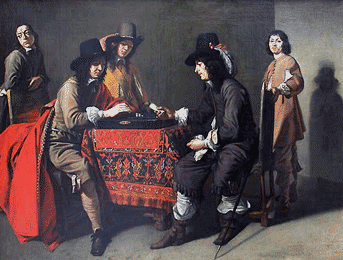|
|
Progress Publishing Co. |
|
|
Basic Strategy Expectations |
|
|
Progress Publishing Co. |
|
|
Basic Strategy Expectations |

![]()

![]()
Basic Strategy Expectations
****************************************************************
House Percentage against Basic Strategy
Effect of the number of decks on a Basic Strategy expectation
Effect of Rules Variations on a Basic Strategy Expectation
Effect of Mistakes on a Basic Strategy Expectation
****************************************************************
Effect of the number of decks on a Basic Strategy expectation
The Basic Strategy expectation depends among other factors on the number of the decks. A single-deck game is more favorable for a player than a multiple-decks game with the same rules. There are two reasons for that - the better chance of getting blackjack and the higher probability of making the hand in a double down situation.
In a single deck game a player has a chance of getting an untied (with a dealer) blackjack and get paid 1.5 of his bet [(2x4x16)/( 52x51)]x[1-(2x3x15)/(50x49)] = 0.0469 or 4.69% of the time. In a six-deck game the probability is [(2x24x96)/(312x311)]x[1-(2x23x95)/(310x309)] = 0.0453 or 4.53% of the time. The chance to get an untied blackjack, to avoid a push with a dealer’s blackjack and get paid at 3:2 ratio in a singe-deck game is 3.52% higher than in a six-deck game.
A player also has better chances of winning a double down bet in a single-deck game than in a six deck game. Suppose a player has an (8,3) versus a dealer’s 6. The probability to draw a 10 is 16/49 = 0.326 or 32.6% of the time. In the six-deck game that probability is equal 96/309 = 0.3106 or 31.06% of the time. Obviously, a player will make a strong hand after a double down more often in a single-deck game.
A table below shows Basic Strategy expectations for the different numbers of the decks and standard Las Vegas rules.
| Number of Decks | Basic Strategy Expectations | House Percentage (Advantage) |
| 1 | -0.0002 |
0.02% |
| 2 | -0.003 |
0.3% |
| 4 | -0.005 | 0.5% |
| 6 | -0.0056 | 0.56% |
| 8 |
-0.0059 |
0.59% |
Effect of Rules Variations on a Basic Strategy Expectation
Blackjack rules differ from casino to casino and from one gambling jurisdiction to another. The rules are important factor that can drastically affect Basic Strategy expectation. A player must always be aware about what rules he is playing under. Some rules are beneficial for a player and improve his expectation. For ex, the dream rule of a Blackjack paying a player at 2:1 instead of 3:2 will increase his expectation by +2.33% in a one-deck game. Increase in player’s expectation means equivalent decrease in house percentage. On the other hand the nightmare rule of a dealer winning the ties will decrease a player’s expectation by about -9%. Decrease of a player’s expectation translates into equal increase of the house advantage. These rules are extreme examples, which occur very rarely during casino promotions or in some variations of Blackjack like “Double Exposure”. Most of the rules variations that occur more frequently, do not affect player’s expectation so dramatically if taken individually. However a combination of few of them can amount to a significant change in expectation one way or another. Below is the table that shows effect in percentage terms of some of the rule variations on a basic strategy expectation for a one-deck game. Most of the rules variations produce similar effects for single and multiple decks.
| Rule Variation | Effect in % on Basic Strategy Expectation |
|
Dealer hits soft 17 |
-0.19 |
| No double on hard 11 |
-0.89 |
| No double on hard 10 | -0.56 |
| No double on hard 9 |
-0.14 |
| No double on soft hands | -0.14 |
|
Doubling on 9, 10 and 11 only |
-0.13 |
| No splitting aces | -0.16 |
| No Blackjack bonus | -2.33 |
| Doubling on 11 only | -0.78 |
| Doubling on 10 and 11 only | -0.26 |
| Drawing to split aces | +0.14 |
| Doubling after pair splitting | +0.13 |
| Doubling on 3 or more cards | +0.20 |
| Resplitting of aces | +0.03 |
| Blackjack pays 2:1 instead 3:2 | +2.33 |
The numbers from this table help to figure out an expectation for every specific set of rules.
Effect of Mistakes on a Basic Strategy Expectation
Mistakes in applying Basic Strategy, even if they are made occasionally, have a
devastating effect on a player’s expectation. Observations made by Peter Griffin
in 1987 drove him to conclusion that casinos’ advantage against a “typical”
player is about 2% in multiple-deck games. That means that statistically average
player plays 1.4% worse than Basic Strategy’s theoretical -0.6 expectation.
Griffin (The Theory of Blackjack) explains that
by the fact that a typical player makes a mistake every 6.5
hands.
Copyright Progress Publishing Co.